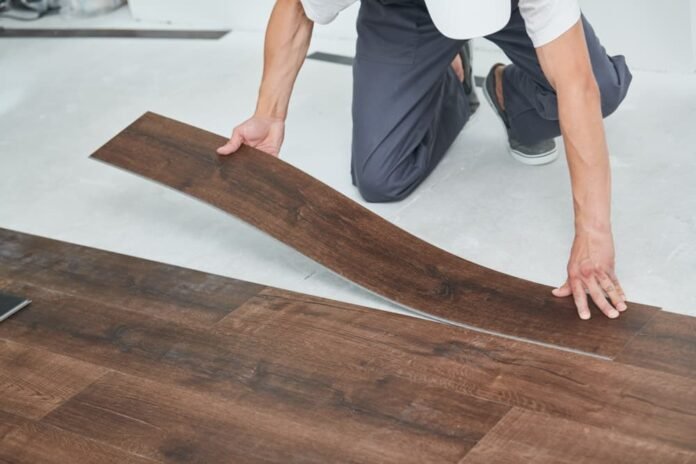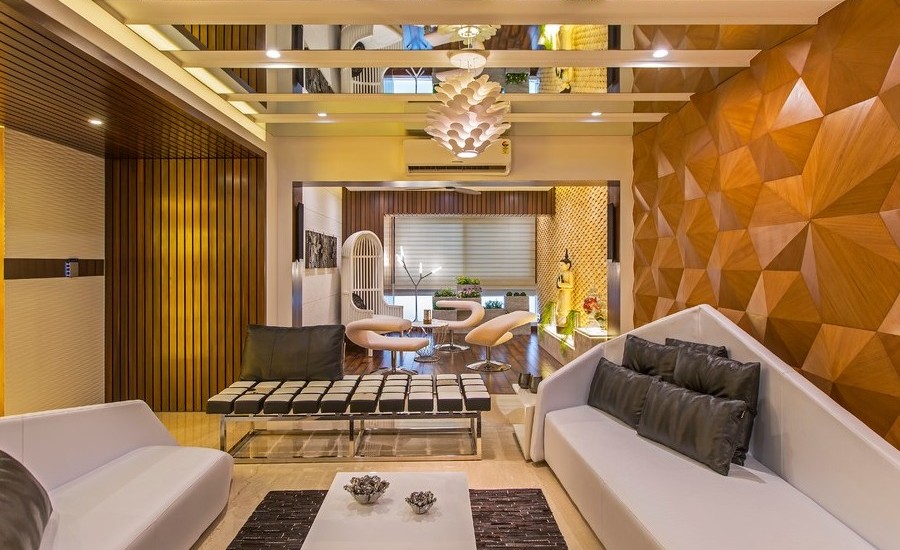Vinyl flooring and laminate flooring have many of the same benefits, including their long lifespan, attractive appearance, relatively low cost, and simple, do-it-yourself installation. Both kinds of flooring, when seen from a distance, seem to be the same.
In the majority of respects, neither one of these flooring options is preferable to the other. Because it is so simple to maintain, vinyl flooring is ideal for use in locations that experience a lot of dampness. Nevertheless, laminate flooring gives a greater selection of design options and has a better resale value than other types of flooring.
What Kind of Flooring Is Vinyl?
Vinyl flooring that is manufactured to industry standards often has four layers of different materials. The backing layer, which is the first of these layers and is located at the bottom, is often constructed of cork or foam. Because it is manufactured to perform the function of an underlayment for the vinyl flooring, it eliminates the need for you to install a separate layer of material before putting down the vinyl flooring. In addition to this, it acts as a cushion, which makes walking on the floor much more bearable, and a sound barrier, which prevents noise from entering the room.
What Kind of Flooring Is Laminate?
Laminate flooring, on the other hand, is made of a synthetic substance, in contrast to natural flooring alternatives such as wood, stone, and cork. The process of lamination fuses together its four distinct layers, which are referred to as the wear layer, the décor layer, the core layer, and the backing layer. It is constructed in such a way that it is both long-lasting and reasonably priced. It is possible to duplicate the appearance of more costly flooring types such as stone, tile, or wood thanks to the décor layer, which is a picture that has been printed.
Comparison of vinyl and laminate flooring, focusing on the key differences
Vinyl Flooring
Vinyl flooring may give the appearance of being made of a single, consistent material, but in reality, it is a layered product, much like laminate flooring. Vinyl flooring is comprised of at least four different layers. The topmost layer is a transparent wear layer, and immediately below that is a high-definition photographic layer. The bulk of the flooring consists of a substantial core layer, and at the very bottom is a layer of plush foam insulation.
Laminate Flooring
Laminate flooring typically has between four and five layers of different types of material. The lowest image layer is a photographic representation of wood or stone, while the uppermost layer is a transparent wear layer that protects it. After the high-density fiberboard, also known as HDF, which makes up the majority of the product, the next layer is an impact-resistant layer that is very thin. The bottommost layer is often comprised of soft foam or, in the case of some laminates, a backer paper layer.
What Kind of Flooring Is Recommended?
Aesthetics and Internal Environment
Vinyl Flooring
Under the tough, transparent wear layer that covers the vinyl planks and tiles used in flooring of higher grade is an image or picture layer. Typically, this depiction is of a kind of wood (such as oak, maple, or hickory), and stone appears here very seldom.
However, not every vinyl flooring has an appearance quite as lifelike as this one does. Sheet and tile vinyl flooring that is older and more affordable is often produced using a rotogravure method (which is similar to a cylindrical printing machine) and is finished with a transparent wear layer.
Laminate Flooring
In order to simulate the appearance of natural wood or stone, laminate flooring always consists of a high-definition photographic layer placed underneath the transparent wear layer.
The most notable characteristic of laminate flooring is its overall look. You can get almost every hue, species, and variation of natural wood and stone flooring in laminate flooring, including hand-scraped, rustic, reclaimed wood, multi-tonal, natural finish, whitewashed, multi-length, and a great deal more. Laminate flooring is also quite affordable.
Upkeep and Tenant Attendance
When cleaning vinyl flooring or laminate flooring, it is recommended to begin with dry techniques such as using a vacuum, brush, broom, or dust mop. This is also true for other types of flooring. In most cases, all that is required is a moist mopping with a detergent that is pH neutral in order to remove entrenched dirt.
The use of a wet mop is how laminate flooring and vinyl flooring are differentiated from one another. When it comes to very grimy flooring, a wet mop might be the quickest and simplest option to clean the floor. While laminate flooring cannot tolerate moisture, vinyl flooring may be cleaned with a damp mop.
Duration of Life
Vinyl Flooring
The lifetime of thinner vinyl flooring is restricted to fewer than 10 years, but the lifespan of thicker vinyl flooring may continue for up to 25 years.
Laminate Flooring
Laminate flooring has a potential lifespan somewhere between 15 and 25 years; but, if it is not properly maintained, it may only last between 5 and 10 years.
Vinyl Flooring’s Price Tag
At cheap retailers, the price of vinyl flooring varies from around $0.60 to $4.00 per square foot. A square foot of sheet vinyl may cost anything from fifty cents to two dollars. However, the expense of installation often more than makes up for the relatively modest cost of sheet vinyl. Do-it-yourselfers are able to install vinyl plank and tile, but sheet vinyl installation is often left to the expertise of a trained professional.
Laminate Flooring
At budget flooring retailers, the price of laminate flooring per square foot may vary anywhere from fifty cents to three dollars. Prices for laminate flooring from well-known brands start at approximately $3.00 per square foot and may go as high as $5.00 to $8.00 per square foot for textured planks that are 12 mm thick.
Expect to spend around $6 or more per square foot, on average, for laminate flooring of a well-known brand that has been professionally installed.
Layout
Vinyl Floor Covering Installation
The installation of vinyl flooring is simple. Either it is adhered to the subfloor with adhesive or it is put loosely on top of it. Glued vinyl flooring may either be found in the shape of tiles or planks, and it can either be adhered together using liquid adhesive or with a backing that has an adhesive that sticks on its own. Vinyl flooring that is installed in a loose-lay fashion is often referred to as a floating floor: The planks only adhere to one other and not to the flooring itself.
Laminate Flooring
There is no such thing as a non-floating laminate floor. Like vinyl flooring, planks connect side-to-side. The weight of the floor combined with the friction keeps it from moving around. Similar to vinyl flooring, laminate flooring may be readily cut by scoring it with a utility knife and then snapping it off. This method is also applicable to hardwood floors.
Vinyl Flooring: Resistant to Water, Heat, and the Environment
The whole surface of a vinyl floor, including the borders and any gaps between planks, is impervious to water. Vinyl flooring that has been drenched in water may be dried out and will not change in size or appearance after being dry.
Heat may have an effect on vinyl flooring, just as it does on any other kind of plastic. The heat criteria that the vast majority of vinyl floorings are able to fulfill, on the other hand, are often set at a level that is far higher (158 degrees Fahrenheit) than what may be anticipated during normal usage.
Laminate Flooring
Because laminate flooring is constructed with a core made of wood, it is particularly susceptible to damage when exposed to water. When water is allowed to pool on the surface, whether at exposed seams or edges, it has the potential to make its way below the surface and into the core of the object. The centre of the earth will drink up all of the water. After being dried, the core will not go back to having the same proportions as before.
The high-density fiberboard that makes up the core of laminate flooring is often unaffected by heat. However, other layers, such as the top wear layer, might potentially melt when subjected to very high temperatures. However, these temperatures are far higher than those that are typical in residential settings, just like vinyl flooring.
Resale Value
Vinyl Flooring
Vinyl floor has traditionally had a low reputation when it comes to restoring resale value; nevertheless, in recent years, thicker and more realistic materials have joined the market, which has led to a rise in vinyl floor’s stature. Despite this, vinyl flooring will often have a lesser value when it comes time to sell compared to laminate flooring.
Laminate Flooring
When it comes to resale value, a solid hardwood or engineered wood floor will fetch more money than a high-quality laminate floor. In spite of this, laminate flooring continues to have a greater resale value than the vast majority of vinyl flooring options.
Top Brands Vinyl Flooring
Armstrong, CoreTEC, Cryntel, Karndean, Mannington, and Metroflor are some of the flooring brands that are available.
Laminate Flooring
Mohawk • Pergo • Shaw • Armstrong • AquaGuard • Dream Home • Shaw • Mohawk • Pergo •
Bottom Line
Vinyl and laminate flooring are essentially equivalent in terms of their usage inside household settings. The majority of the elements that influence the selection are personal, including the alternatives for styles, the textures, and the pricing. The use of water is the one circumstance in which vinyl and laminate cannot be interchanged. Vinyl flooring is undeniably superior than laminate flooring when it comes to withstanding high levels of moisture, which makes it a fantastic option for use in areas like bathrooms. However, since it comes in such a broad variety of styles and colors, laminate flooring is often the best option when it comes to installing it across a whole home.
Without the related expenses or upkeep demands, you may create the opulent impression of stone and exotic woods. Vinyl can also be swiftly and easily removed in the event that it has to be replaced and is moisture-resistant. It’s a great material for homes with pets because of this. Customers may choose from an extensive selection of vinyl flooring at SD Wood Cabinet, including a variety of colors, surface textures, and design possibilities.
Having the largest San Diego Vinyl Flooring Showroom, SD Wood Cabinet offers a bewildering array of colors and designs. Our portfolio is continually current and includes the sexiest styles that are readily available right now.



















